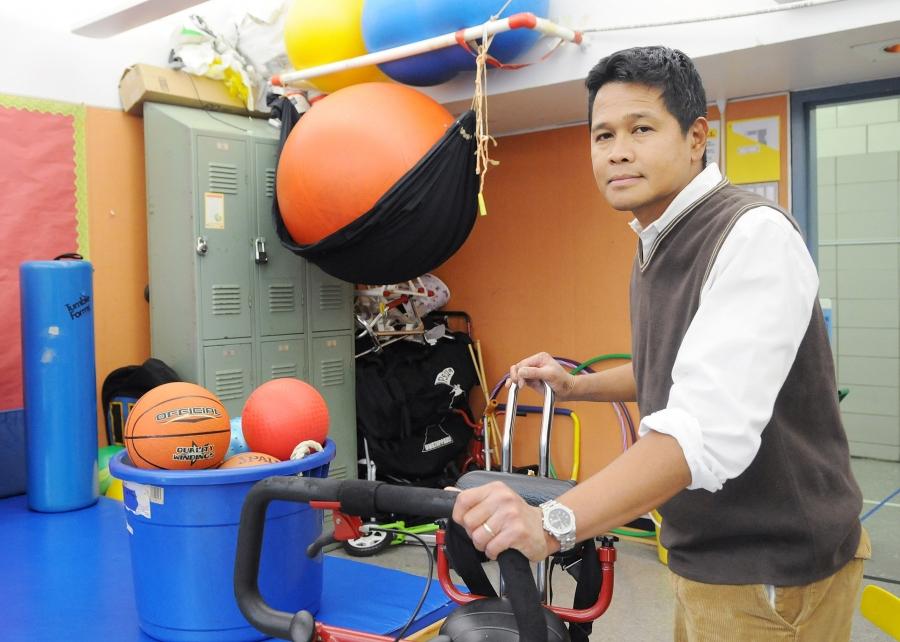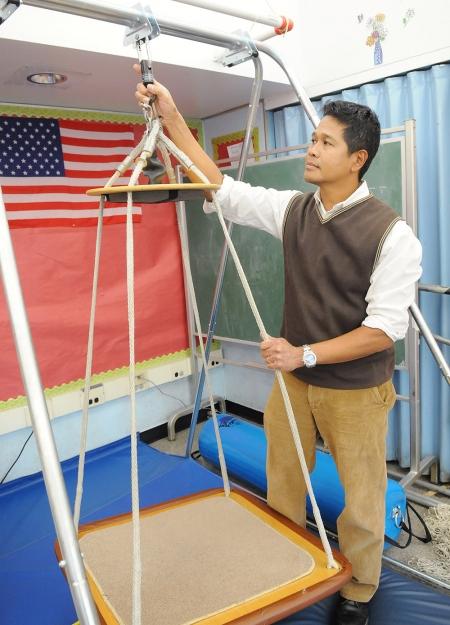How has physical therapy changed over the years?
The focus is now more on function and participation. The need for data has increased exponentially over the years thereby increasing paperwork and accountability. To provide quality therapy and at the same time keep up with increased paperwork is the challenge that therapists face in today’s work environment. And yes, though sometimes daunting, it is possible.
What’s the most rewarding aspect of your job?
The most rewarding aspect far and away is changing a student's conception from, "I want to do that but I can't do that!" to, "Oh wow, I can do it." Even for the less expressive students, you can see it in their faces. Teachers equate this face as that "light bulb goes on" face — the exact moment they understand something. When it's important to them to do better in physical education, field day or at the Victory Challenge Games for the Physically Challenged, I get to impart what I know about each sport. For example, letting the students see in themselves "what I did to throw farther" or hit straighter or shoot higher. That's rewarding for them and me.
One example that comes to mind: There is the Dancing Classrooms’ program in which 4th-grade students learn seven dances. Adapting these dances for a student who uses a wheelchair, who uses a walker, or who has one-sided weakness, is challenging for both the student and myself. And then it works … that's rewarding.
Please tell us about some of your student success stories?
I remember a first grader who had syndactyly on both hands. Syndactyly results when fingers fail to separate during embryonic development. Fingers are conjoined by skin, soft tissue and bone. I don't remember why he didn't have surgery when he was younger. He was a smart, witty, little boy with an unbreakable positive attitude. His class was learning to play the recorder, a wind instrument. He wanted to play with and sound like the rest of his class but he was only able to cover two of the holes on his recorder with his fingers. His teacher said his one-note playing drowned out what the rest of the class was playing. She asked me if I could work with him to learn to play the recorder.
The B note was easy. All he had to do was cover two holes on the instrument with his thumb and finger. All the other notes required anywhere from three to 10 holes covered simultaneously.
I came up with a series of clear, overlapping, plastic flaps that I glue-gunned to his recorder. Pressing down on one flap would cover all the holes at once for the note of C, pressing on another flap would cover the holes for the note of G, and so on. We both got that "light bulb goes on" face the moment he started playing and each of his notes were distinct.
I remember a kindergartener who used a wheelchair but did not self-propel. He had a difficult time controlling the movements of his arms and legs.The general consensus was that I should concentrate on wheelchair mobility, but his parents requested that I work on ambulation. After much discussion, I told them I would work on both. Even with HKAFOs [hip-knee-ankle-foot-orthosis — a brace] and a Mullholland gait trainer, I didn’t think he’d be successful, but he worked so hard that I just followed his lead. We tried different braces and a different gait trainer. Good thing we continued because he progressed to using a Wenzylite safety walker with forearm supports, to an aluminum walker and finally to Lofstrand crutches. I'm so proud of him.
How has your union supported you in your years working as a physical therapist?
The UFT has provided assistance in getting fairer treatment for physical and occupational therapists. Over the years, the UFT has negotiated a more competitive pay scale that reimburses us for our education and experience, thus lessening the need for my colleagues to have to do early intervention or similar second jobs to make ends meet.
Also, teachers always had the option to work during the summer and get compensated, whereas previously, all therapists had a 12-month mandate to work. The UFT assisted on the path that led us to get extra pay for working in the summer. [Editor’s note: In 2005, the UFT negotiated for therapists and nurses the 10-month year, including all school holidays, to provide parity with teacher titles and paraprofessionals.]
How do you build rapport and motivate the students with whom you work?
By finding out what you have in common with them and using that to connect at their level. If that's not possible, I try to take an interest in what they're into or try to learn from them. This is especially important with students with Autism Spectrum Disorder. In some instances, they're hyper focused on things. Unfortunately, these interests aren't the lesson or work at hand. Instead of tagging these interests as interferences to be discouraged, you’ve got to be creative. I had one student obsessed with Nintendo's Super Mario. We needed to work on balance, body position sense, coordination and mid-range control. We set up an obstacle course that required him to step over, duck under without going down on his knees and go between. I used language from the game to encourage him. We'd call the obstacles "piranha plants" or "koopas." If he touched them or knocked them over he would "lose a life." He had to pick up as many bean bags, or "coins, as he could off the floor. If he picked up the medicine ball and placed it in a barrel he would get a "1up." Relating things we do in therapy with those interests is key. I had a student who needed to work on graded, controlled movement of his upper extremities. We both loved “Star Wars” so we choreographed, step by step, a lightsaber duel. Rewards for great work has to be relevant. Spend the money on Marvel stickers instead of smiley faces.
Please tell us a little about your experience as a head coach for Team Unstoppable and the Victory Challenge Games for the Physically Challenged.
Originally, it was called the Empire State Games for the Physically Challenged. I've been volunteering for the Games for over 22 years. It's a great sporting event and one of the few venues where athletes with physical challenges can compete with other athletes with similar physical challenges.
Challenges include asthma, hearing impairment, vision impairment and autism. On the last day of the games, athletes attend a dance where they watch a film of the competition set to music. They, like the other schools, cheer every time they or their teammates appear on the big screen. When they didn't make it on the video, it was such a letdown to an otherwise great trip. So we decided to start making our own highlight reel and produced our own medal ceremony where our athletes could be featured and receive their medals in front of their peers and families. That's how I fell into film.
You direct school plays, skits and dances. How do you feel these creative projects complement students’ therapeutic progress?
As I mentioned previously, do anything you can to allow them to participate, function, and keep up in both academic and non-academic activities. Anything that will allow them to be a part of their school experience. I've been asked by my students to help them put together an act so that they can make it into the school talent show. Putting together choreography that they're able to coordinate and still look "cool" is usually the request. Blending physical therapy and art. Who knew? When they’re practicing skills to create something they want to be proud of, you see an increased degree of carryover of those skills in other aspects of life.
What do you love about PS 229?
I love that PS 229 has progressively included the special education students. Through the years, they have been included in more and more events and activities alongside the general education population including in Dancing Classrooms and on field day. We have a great parent-teacher association and a very supportive staff.
The staff is very talented. I've been lucky to have been part of a theater group, which included therapists, teachers, paraprofessionals, school psychologists and family workers, that put together a Halloween play. They would stay after school to rehearse, work on props and make costumes. Funding came from their own pockets. We've brought books such as "Where the Wild Things Are" to life. Last year, we did Harry Potter. Teachers and parents have come up to us saying that their kids are now reading the series.

